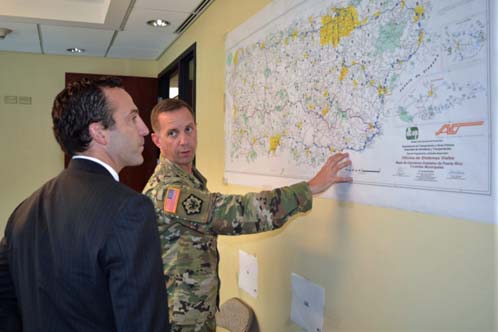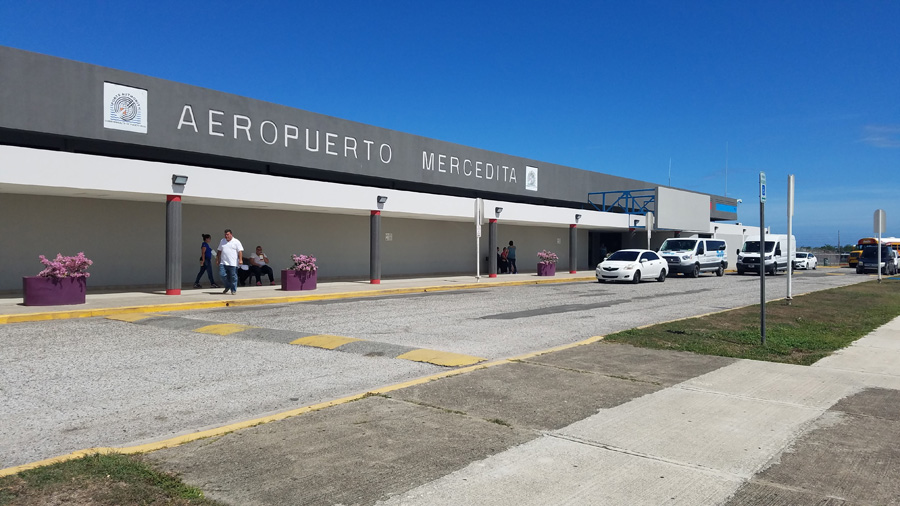USACE: New goal is to keep PR’s generators operational


Puerto Rico Recovery Field Office Commander Col. James DeLapp provides an overview of U.S. Army Corps of Engineers mission locations around the island to Assistant to the President Reed Cordish, from the White House Office of American Innovation during a recent visit. (Credit: U.S. Army photo by Edward Rivera)
At the request of Puerto Rico Gov. Ricardo Rosselló, the Federal Emergency Management Agency tasked the U.S. Army Corps of Engineers to maintain and repair non-federally installed generators.
USACE deployed its Honolulu District Temporary Emergency Power Planning and Response Team and contracted with Louis Berger to take on this unprecedented mission, the agency said.
The significant damage caused by Hurrícane Maria to the island’s power infrastructure resulted in long-term power service disruptions.
Jackie Conant, mission liaison said the additional team was deployed to supplement the work being performed under the traditional temporary emergency power mission, which is responsible for providing temporary emergency power to critical public facilities with government-owned or leased generators.
“The goal for this supplementary mission is to repair and maintain the facility-owned and already installed generator to prevent having to install a FEMA generator,” Conant said.
Unlike the traditional Temporary Emergency Power mission, which installs FEMA provided generators from a pre-determined list of manufacturers, the “Non-Fed” team has to be prepared to service, maintain and repair generators from all makes, models, sizes, and ages, the agency added.
“This is a unique, never-been-done-before mission with a variety of challenges,” said Recovery Field Office Commander Col. James DeLapp. “There are generators in use that are no longer being made, one generator that we recently repaired is almost 60 years old.”
To date FEMA has tasked the “Non-Fed” team with assessing 148 facilities containing approximately 180 generators. They have completed 85 assessments with 29 still in progress.
The “Non-Fed” generators are providing power to hospitals and clinics, waste water treatment plants, water pumps, telecommunications hubs, and other facilities deemed critical by FEMA.
“At the moment about 40 percent of the generators are fully working,” Conant said. “As we continue to receive parts and help from technical experts more generators will be working at full capacity.”
“Similar to the upkeep of a car, a generator requires maintenance and repair due to usage,” said Darin Aihara, mission manager. “Once a facility is approved by FEMA to be included under the “Non-Fed” mission, the facility is assessed by an assessment team and the team determines if the generators require repair, maintenance, or both.”
Typically, for emergency or stand-by generators, most manufacturers recommend servicing every 240 hours of runtime. The 240-hour servicing includes the replacement of the oil and fuel filters, and the visual inspection of the air filters, belts, and radiator coolant quality and levels.
If an assessment reveals that repairs are required, as soon as the parts are available, a team of electricians and mechanics will be sent to the generator and perform the repairs.
If the assessment determines the generator is irreparable or if the repair exceeds the allowances of the mission, the facility will be able to request the traditional temporary Emergency Power mission to install a FEMA provided generator until commercial power is restored, Conant said.
“The devastation caused by Hurricane María continues to provide different and changing environmental challenges to missions like the “Non-Fed” generator maintenance and repair mission,” said DeLapp.
“Hurricane María’s damage to Puerto Rico’s ports, airfields, roads, bridges, electric grid and communications has slowed some recovery efforts but conditions and the pace of recovery continues to improve daily,” he said.










